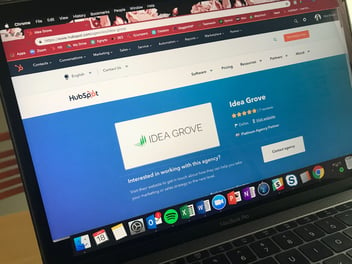One of the biggest disconnects I’ve seen in my years in B2B is between sales and marketing teams. Too often these teams are operating from separate agendas driven by different goals, different processes, and different perspectives on the best ways to help the company grow. This disconnect is painful and can set even the best marketing and sales teams up for a struggle.
As a HubSpot partner agency, we have the pleasure of co-leading the DFW HubSpot User Group (HUG) with regular events that share insights on the keys to successful HubSpot marketing campaigns. We recently hosted our first Virtual HUG session with none other than Dan Tyre, HubSpot employee #6 and the company’s leading sales trainer. (I recently went through his sales bootcamp program where I learned that introverts like myself can indeed make awesome sales people).
We spent an hour picking his brain about how you start aligning sales and marketing and why it’s so important. Here are a few of our top takeaways.
Have a Common Vocabulary
This is especially important for understanding how sales and marketing qualify leads as they convert and engage. If you’re not aligned, chances are what marketing thinks qualifies as an SQL is probably different from what sales thinks qualifies as one. Marketing teams are tasked with filling the funnel with new leads, qualifying them (MQLs), and getting them ready to hand off to sales (SQLs). Sales teams are responsible for taking those leads, disqualifying poor-fit leads, and turning good-fit leads into opportunities.
A good SMarketing starting point is to create clear, shared definitions for each lifecycle stage in your funnel. Decide what exactly differentiates a lead from an MQL and an MQL from an SQL in the context of your marketing campaigns and sales processes.
Create an SLA Between Sales and Marketing
You likely have some sort of a service level agreement (SLA) in place for your customers that clearly outlines what services or deliverables you will provide. Once you have clearly defined how you’re defining contacts as they move through your funnel, put it in writing. HubSpot has a great guide for creating an SLA between sales and marketing (including a free template), but, ultimately, you want to use this document to establish the deliverables that are expected from each team, including:
- Summary of the agreement
- Goals for both sales and marketing
- What’s needed from both teams
- What will happen if goals are not met
Once you create your SLA, it’s clear what each department is responsible for delivering to the other. Since it’s in writing and both teams have agreed to the terms, it eliminates any blame or finger pointing any time there is a issue.
Let the Communication Flow
Your sales and marketing teams are likely having individual team meetings regularly, but are they communicating across the aisle just as often? Both teams should be meeting weekly to review progress, have an honest evaluation of any potholes that are interfering with your progress towards your goals, and track everything with data and analytics. Don’t wait until you start falling behind on goals to open up the lines of communication.
You’re Only as SMart as Your Tools
The key to seamless synergy between marketing and sales teams is having all your information in one place. If you’re using one tool for your marketing automation and another one as your CRM for sales, even if they’re integrated, there are likely information gaps that might cause hiccups in a lead’s experience with your company.
Does sales have full insight into how that lead originated? Did they watch a webinar, download a whitepaper, or request a demo? What pages on your site have they viewed? Similarly, does marketing know which lead sources are converting lower quality leads so they can optimize and improve their campaigns?
Yes, it’s possible to do this with different tools, but it’s much more time consuming and challenging to integrate. When you unify into a single tool, it makes the coordination between sales and marketing much more seamless.
Sales and Marketing alignment won’t happen overnight, but if you invest in the best practices and develop processes that address the needs and concerns of both teams equally, your conversion ratios will benefit.
The DFWHUG holds regular free meetups that are open to all HubSpot users to help them master all things strategy and software. You can join the community here or find your local chapter if you’re outside of Dallas/Fort Worth!
Want to learn more about HubSpot?

 4 min read
4 min read






 2 min read
2 min read

